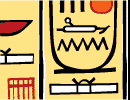Keys to this period
1) Settlements were first established along the Nile River.
2) Hieroglyphs also made their first appearance around the end of this period.
Summary
Nearly 60,000 years ago the Nile River began its yearly inundation of the land along its banks, leaving behind rich alluvial soil. These areas close to the floodplain became an attractive source of food and water. In time, the climatic changes of this landscape (including periods of aridity) further served to confine human habitation to the Nile Valley, although this case was not always true. From the Chalcolithic period (the Copper age) [~4000 B.C.] into the early part of the Old Kingdom [~2685 B.C.], people apparently used an extended part of the land. In the 7000 B.C., the landscape of Egypt was hospitable and evidence of settlements from that time have been found in the low desert areas of southern, or "Upper Egypt"; remains of similar occupation have been discovered at Nubian sites in the modern Sudan. Enough pottery has been found in Upper Egyptian tombs from ~4000 BC (Predynastic period) to establish a relative dating sequence. The Predynastic period, which ended with the unification of Upper and Lower Egypt under one king (see Archaic Period), is generally subdivided into three parts. Each of which refers to the site at which its archaeological materials were found: Badarian, Amratian (Naqada I), and Gerzean (Naqada II and III). This period began with a 0 Dynasty, which had as many as 13 rulers, ending with Narmer (~ 3050 B.C.)
|
|
|





